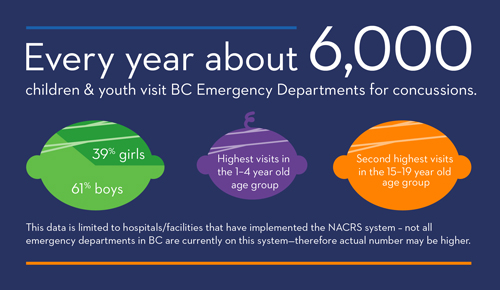JUMP TO: ACTIONS WHERE ARE WE NOW DOCUMENTS & REPORTS
Background/ Why Is This Important?
Concussions are a significant health issue for children and youth throughout British Columbia, accounting for more than 6,800 recorded visits to BC Emergency Departments in 2014/15. The actual number of concussion injuries is estimated to be much higher.
Evidence suggests that children and adolescents take longer than adults to recover following a concussion.
While 85% individuals who suffer a concussion will have symptoms that resolve with no long-term consequences if diagnosed accurately and given the correct treatment protocol, approximately 10 - 15% of people who suffer concussions will have prolonged symptoms and require specialized services. Therefore, concussion management and appropriate return to activity and school is crucial, particularly in pediatric and adolescent populations.
Child Health BC has identified injury prevention – concussion in particular – as a priority area to focus its activities.
What Actions Have Already Been Taken?
Child Health BC partnered with the BC Injury Prevention and Research Unit (BCIRPU) to complete some foundational work that would support a provincial approach to concussion prevention. Initial work included production of a number of reports that document the burden of concussion in BC overall and among BC children and youth.
Child Health BC has also contributed to the development of the Concussion Awareness Training Toolkit (CATT), an online resource that supports standardized concussion recognition, diagnosis, treatment and management. This initiative is led by Dr. Shelina Babul, BCIRPU Associate Director/Sports Injury Specialist, and features modules tailored for medical professionals; parents, players and coaches; and educators and health practitioners.
In 2015, Child Health BC organized a province-wide collaborative review of newly-released Guidelines for Diagnosing and Management of Pediatric Concussions. The goal of this process was to help determine a provincial approach for the assessment, management and treatment of concussion and post-concussive syndrome in children and youth.
This work confirmed a lack of publicly-available services for children with concussion in many regions of the province. It also identified a lack of Tier 4 regional and Tier 6 provincial services for all children with very acute and/or complex concussions and/or those who experience post-concussive symptoms.
Where Are We Now?
The Concussion Awareness Training Toolkit (CATT) has launched a new, more user-friendly website that also incorporates the 5th International Consensus Statement on Concussion in Sport August 2017. CATT information for medical professionals has been updated to include treatment and management protocols.


